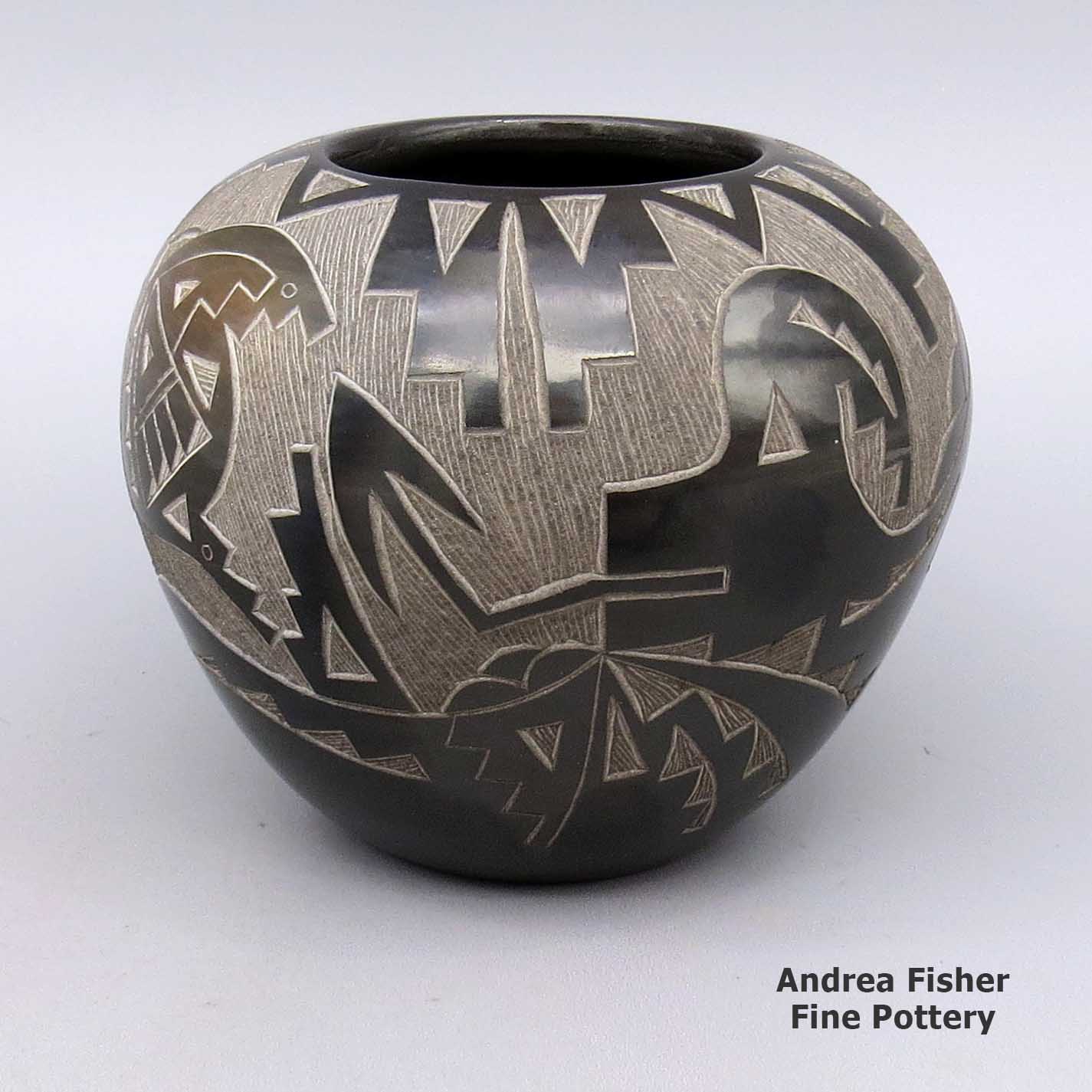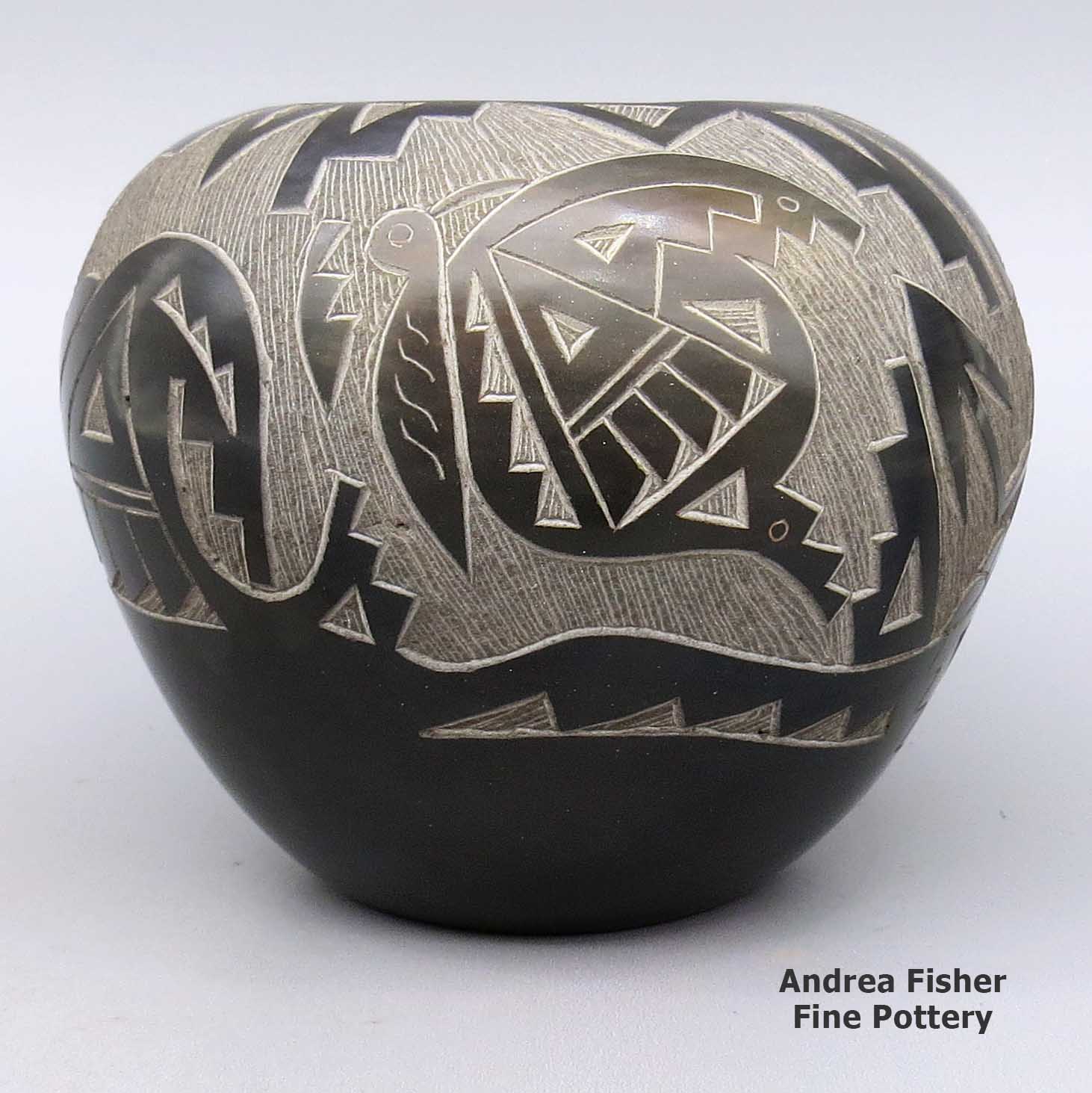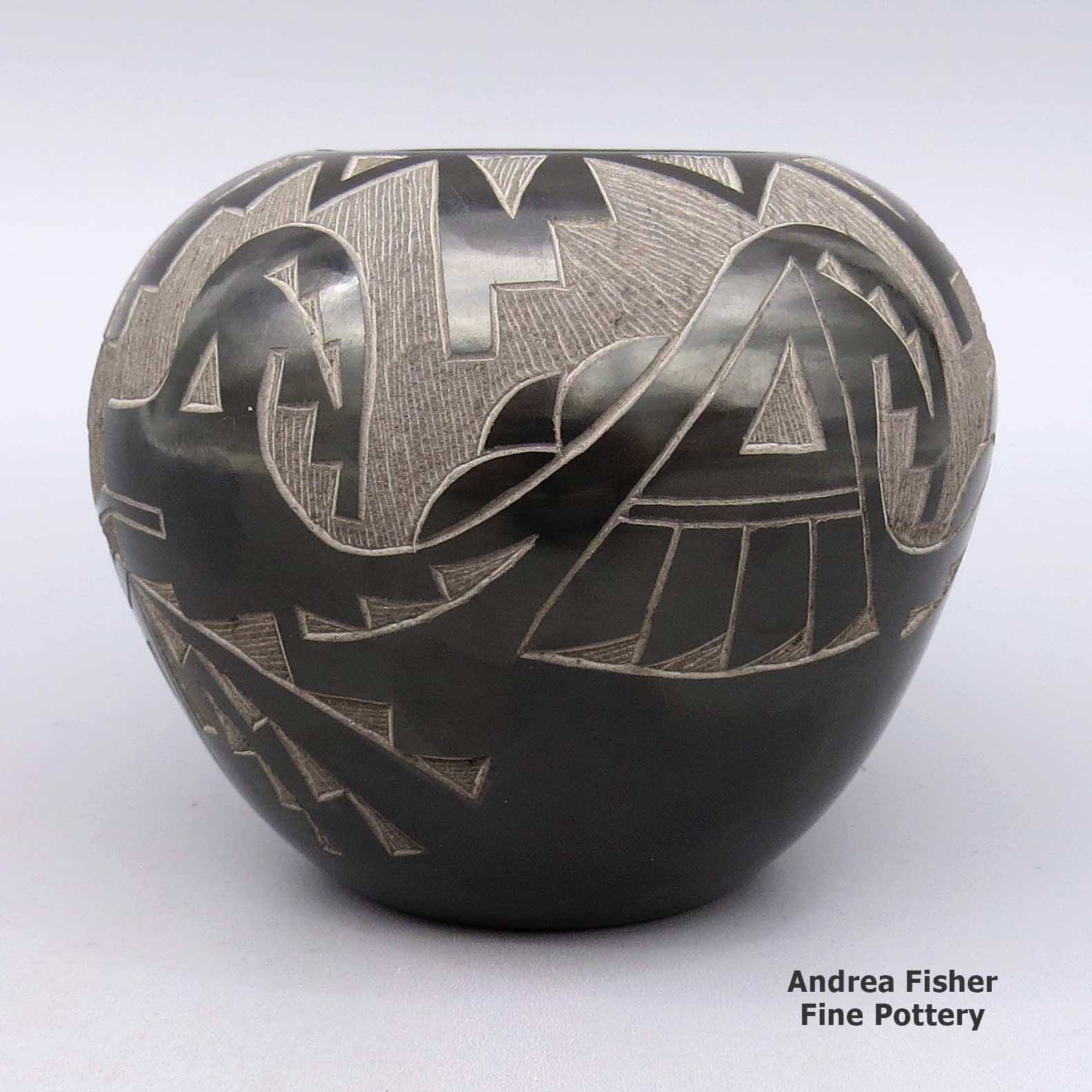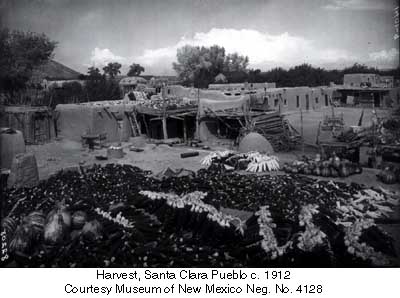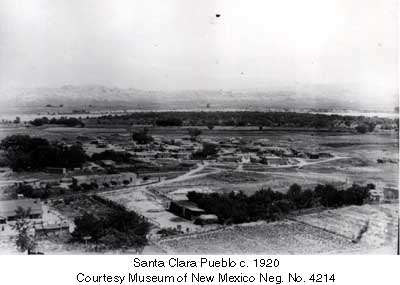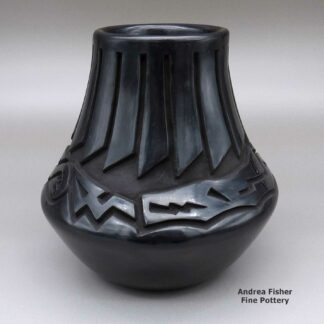| Dimensions | 4 × 4 × 3.5 in |
|---|---|
| Condition of Piece | Excellent |
| Date Born | 2022 |
| Signature | Candelaria Suazo Santa Clara Pueblo |
Candelaria Suazo, zzsc2m091, Black bowl with sgraffito design
$325.00
A black bowl with a sienna spot and a sgraffito avanyu, Mimbres butterfly and geometric design
In stock
Brand
Suazo, Candelaria
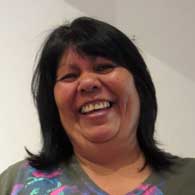 Candelaria Suazo was born to Joe and Santanita Suazo of Santa Clara Pueblo and Ohkay Owingeh in the late 1950s. She has been making pottery since she was 20 years old. Among her teachers and those who still inspire her are her mother and her sisters: Margie Naranjo, Martha Haungooah, Mae Tapia and Shirley Duran. Relatives Dolores Curran and Geri Naranjo also had a great influence on her work over the years.
Candelaria Suazo was born to Joe and Santanita Suazo of Santa Clara Pueblo and Ohkay Owingeh in the late 1950s. She has been making pottery since she was 20 years old. Among her teachers and those who still inspire her are her mother and her sisters: Margie Naranjo, Martha Haungooah, Mae Tapia and Shirley Duran. Relatives Dolores Curran and Geri Naranjo also had a great influence on her work over the years.Making pueblo pottery is a complex and time consuming occupation. The most critical moments are in mixing the clay at the beginning and in the last step: firing the pot outdoors.
Candelaria digs and mixes her own clay. She uses a series of screens to sift and remove impurities. Each pot is coiled and shaped by hand, not thrown on a wheel. No glazes are used, only a stone to polish the piece. The pot is fired outdoors in a traditional firing pit using "cow patties" and dry horse manure. To obtain a black finish, a reduction process is employed where the pots are smothered with a mix of ashes and pulverized manure.
Candelaria tells us her favorite shapes to work with include miniature bowls and vases. The sgraffito (etched) style that she specializes in is accomplished after the "smothering" process that turns the pottery black. A figure such as a finely etched avanyu (the mythic Tewa water serpent) will surround the entire pot. Often kiva steps and cloud designs will complete the work. Other favored designs are butterflies and/or hummingbirds that are intricately carved on opposite sides of a piece. She also uses a special technique that highlights part of a piece by reheating a section of it and re-oxygenating it, changing its color back to reddish.
Candelaria says, "I enjoy making pottery because I want to keep up the traditional art of pottery making that the pueblo of Santa Clara is known for." She exhibits at the Eight Northern Pueblos Arts and Crafts Show and has earned several ribbons for First, Second and Third Places. She signs her work: "Candelaria Suazo, Santa Clara Pueblo."
A Short History of Santa Clara Pueblo

Santa Clara Pueblo straddles the Rio Grande about 25 miles north of Santa Fe. Of all the pueblos, Santa Clara has the largest number of potters.
The ancestral roots of the Santa Clara people have been traced to ancient pueblos in the Mesa Verde region in southwestern Colorado. When the weather in that area began to get dry between about 1100 and 1300 CE, some of the people migrated to the Chama River Valley and constructed Poshuouinge (about 3 miles south of what is now Abiquiu on the edge of the mesa above the Chama River). Eventually reaching two and three stories high with up to 700 rooms on the ground floor, Poshuouinge was inhabited from about 1375 CE to about 1475 CE.
Drought then again forced the people to move. One group of the people went to the area of Puyé (along Santa Clara Canyon, cut into the eastern slopes of the Pajarito Plateau of the Jemez Mountains). Another group went south of there to what we now call Tsankawi. A third group went a bit to the north, following the Rio Chama down to where it met the Rio Grande and founded Ohkay Owingeh on the northwest side of that confluence.
Beginning around 1580, another drought forced the residents of the Puyé area to relocate closer to the Rio Grande. There, near the point where Santa Clara Creek merged into the Rio Grande, they founded what we now know as Santa Clara Pueblo. Ohkay Owingeh was to the north on the other side of the Rio Chama. That same dry spell forced the people down the hill from Tsankawi to the Rio Grande where they founded San Ildefonso Pueblo to the south of Santa Clara, on the other side of Black Mesa.
In 1598 Spanish colonists from nearby Yunqué (the seat of Spanish government near the renamed "San Juan de los Caballeros" Pueblo) brought the first missionaries to Santa Clara. That led to the first mission church being built around 1622. However, the Santa Clarans chafed under the weight of Spanish rule like the other pueblos did and were in the forefront of the Pueblo Revolt of 1680. One pueblo resident, a mixed black and Tewa man named Domingo Naranjo, was one of the rebellion's ringleaders.
When Don Diego de Vargas came back to the area in 1694, he found most of the Santa Clarans were set up on top of nearby Black Mesa (with the people of San Ildefonso, Pojoaque, Tesuque and Nambé). An extended siege didn't subdue them but eventually, the two sides negotiated a treaty and the people returned to their pueblos. However, successive invasions and occupations by northern Europeans took their toll on the pueblos over the next 250 years. The Spanish flu pandemic in 1918 almost wiped them out.
Today, Santa Clara Pueblo is home to as many as 2,600 people and they comprise probably the largest per capita number of artists of any North American tribe (estimates of the number of potters run as high as 1-in-4 residents).
For more info:Pueblos of the Rio Grande, Daniel Gibson, ISBN-13:978-1-887896-26-9, Rio Nuevo Publishers, 2001
Upper photo courtesy of Einar Kvaran, Creative Commons Attribution-Share Alike 3.0 Unported License
About Bowls
The bowl is a basic utilitarian shape, a round container more wide than deep with a rim that is easy to pour or sip from without spilling the contents. A jar, on the other hand, tends to be more tall and less wide with a smaller opening. That makes the jar better for cooking or storage than for eating from. Among the Ancestral Puebloans both shapes were among their most common forms of pottery.
Most folks ate their meals as a broth with beans, squash, corn, whatever else might be in season and whatever meat was available. The whole village (or maybe just the family) might cook in common in a large ceramic jar, then serve the people in their individual bowls.
Bowls were such a central part of life back then that the people of the Classic Mimbres society even buried their dead with their individual bowls placed over their faces, with a "kill hole" in the bottom to let the spirit escape. Those bowls were almost always decorated on the interior (mostly black-on-white, color came into use a couple generations before the collapse of their society and abandonment of the area). They were seldom decorated on the exterior.
It has been conjectured that when the great migrations of the 11th, 12th, 13th and 14th centuries were happening, old societal structures had to change and communal feasting grew as a means to meet, greet, mingle with and merge newly arrived immigrants into an already established village. That process called for larger cooking vessels, larger serving vessels and larger eating bowls. It also brought about a convergence of techniques, styles, decorations and design palettes as the people in each locality adapted. Or didn't: the people in the Gallina Highlands were notorious for their refusal to adapt and modernize for several hundred years. They even enforced a No Man's Land between their territory and that of the Great Houses of Chaco Canyon, killing any and all foreign intruders. Eventually, they seem to have merged with the Towa as those people migrated from the Four Corners area to the southern Jemez Mountains.
Traditional bowls lost that societal importance when mass-produced cookware and dishware appeared. But, like most other Native American pottery in the last 150 years, market forces caused them to morph into artwork.
Bowls also have other uses. The Zias and the Santo Domingos are known for their large dough bowls, serving bowls, hair-washing bowls and smaller chili bowls. Historically, these utilitarian bowls have been decorated on their exteriors. More recently, they've been getting decorated on the interior, too.
The bowl has also morphed into other forms, like Marilyn Ray's Friendship Bowls with children, puppies, birds, lizards and turtles playing on and in them. Or Betty Manygoats' bowls encrusted with appliqués of horned toads or Reynaldo Quezada's large, glossy black corrugated bowls with custom ceramic black stands.
When it comes to low-shouldered but wide circumference ceramic pieces (such as many Sikyátki-Revival and Hawikuh-Revival pieces are), are those jars or bowls? Conjecture is that the shape allows two hands to hold the piece securely by the solid body while tipping it up to sip or eat from the narrower opening. That narrower opening, though, is what makes it a jar. The decorations on it indicate that it is more likely a serving vessel than a cooking vessel.
This is where our hindsight gets fuzzy. In the days of Sikyátki, those potters used lignite coal to fire their pieces. That coal made a hotter fire than wood or manure (which wasn't available until the Spanish brought it). That hotter fire required different formulations of temper-to-clay and mineral paints. Those pieces were perhaps more solid and liquid resistant than most modern Hopi pottery is: many Sikyátki pieces survived intact after being slowly buried in the sand and exposed to the desert elements for hundreds of years. Many others were broken but were relatively easy to reassemble as their constituent pieces were found all in one spot and they survived the elements. Today's pottery, made the traditional way, wouldn't survive like that. But that ancient pottery might have been solid enough to be used for cooking purposes, back in the day.
About the Mimbres Culture
The Mimbres culture existed in the Mimbres Valley of southern New Mexico from about 850 CE to about 1150 CE. They were a sub-culture of the greater Mogollon culture that extended from the west coast of Mexico east across the Sierra Madre Mountains, north to the San Andres Mountains and northwest along the Mogollon Rim to the vicinity of today's Springerville, AZ.
North of the Gila Mountains was the influence of the Great Houses of the Chaco culture. Through comparisons of imagery and the colors used, it has been conjectured that Chaco was a more male dominant society while Mimbres was more female dominant. Both areas were settled, built, flowered and abandoned on almost exactly the same time schedules. But at the time of abandonment, the folks of Chaco mostly moved north while those of the Mimbres valley mostly went south.
The Mimbres people were among the first cultures that evolved their own forms of imagery and means of telling stories through those images. The Classic Mimbres period was the height of their creativity, from about 1000 CE to about 1150 CE. Then things changed and migrations began in earnest. Many moved south and brought some of their art to Paquimé. Others pushed north and then west, around the Gila Mountains. By 1200 CE the vast majority of the people in the area of the Mimbres Valley had moved elsewhere.
Most Mimbres pottery was black-on-white. Around 1120 CE there was an influx of migrants from Hohokam and Salado areas to the west. That's about when the first black-on-red pottery appeared in the Mimbres villages. Some of the imagery we see today from many of the Northern and Middle Rio Grande pueblos had its origins in the Mimbres Valley.
Substantial depopulation of the area occurred shortly after 1150 CE but there were many small surviving populations scattered around. Over time, these melted into the surrounding cultures with many families moving north to Acoma, Zuni and Hopi while others moved south to Casas Grande and Paquimé.
The greater Mogollon culture spanned the countryside from the west coast of Mexico east across the Sierra Madre to Paquimé, then north through the Mimbres Valley to the edge of the White Sands and then northwest along the Mogollon Rim into east-central Arizona.
The time period from about 850 CE to about 1000 CE is classed the Late Basketmaker III period across the Southwest. The time period was characterized by the evolution of square and rectangular pithouses with plastered floors and walls. Ceremonial structures were generally dug deep into the ground. In the Mimbres Valley area, local forms of pottery have been classified as early Mimbres black-on-white (formerly Boldface Black-on-White), textured plainware and red-on-cream.
The Classic Mimbres phase (1000 CE to 1150 CE) was marked with the construction of larger buildings in clusters of communities around open plazas. Some constructions had up to 150 rooms. Most groupings of rooms included a ceremonial room, although smaller square or rectangular underground kivas with roof openings were also being used. Classic Mimbres settlements were located in areas with well-watered floodplains available, suitable for the growing of maize, squash and beans. The villages were limited in size by the ability of the local area to grow enough food to support the village.
Pottery produced in the Mimbres region is distinct in style and decoration. Early Mimbres black-on-white pottery was primarily decorated with bold geometric designs, although some early pieces show human and animal figures. Over time the rendering of figurative and geometric designs grew more refined, sophisticated and diverse, suggesting community prosperity and a rich ceremonial life. Classic Mimbres black-on-white pottery is also characterized by bold geometric shapes executed with refined brushwork and very fine linework. Designs may include figures of one or more humans, animals or other shapes, bounded by either geometric decorations or by simple rim bands. A common figure on a Mimbres pot is the turkey, others are the thunderbird, rabbit and various anthropomorphic, half-human figures. There are also a lot of different fish depicted, some are species found only in the Gulf of California (hundreds of miles away across the desert).
A lot of Mimbres bowls (with kill holes) have been found in archaeological excavations but most Mimbres pottery shows evidence it was actually used in day-to-day life and wasn't produced just for burial purposes.
There's a lot of speculation as to what happened to the Mimbres people as their countryside was rapidly depopulated after about 1150 CE. The people of Isleta, Acoma and Laguna find ancient Mimbres pot shards on their pueblo lands, indicating that pottery designs from the Mimbres River area migrated north. There are similar designs found on pot shards littering the ground around Casas Grandes and Paquimé near Mata Ortiz and Nuevo Casas Grandes in northern Mexico. Other than where they went, the only reasons offered for why they left involve at least small scale climate change. The usual comment is "drought" but drought could have been brought on by the eruption of a volcano on the other side of the planet, or a small change in the El Nino-La Nina schedule. Whatever it was that started the outflow of people, it began in the Mimbres River area and spread outward from there. Excavations in the eastern Mimbres region (nearer to Truth or Consequences, New Mexico) have shown that the people adapted to new circumstances and that adaptation itself moved them closer into alignment with surrounding villages and cultures. Eventually they just kind of merged into the background population.
The groups that moved south and built up Paquimé and Casas Grandes became powerful and wealthy over the next couple hundred years. Then they seem to have lost a war in the mid-1400s and the survivors were forced to migrate to the west, to a land a bit more hospitable for them at the time. It's also quite possible that they were defeated by volcanic eruptions on the other side of the planet: the 1100s, 1200s and 1300s were a time of migration in many parts of the world because of continuing bad weather events. The Little Ice Age that saw temperatures in the Northern Hemisphere drop as much as 2°C began in the early 1300s and lasted into the mid 1800s. NASA feels that this was mostly a result of large volumes of volcanic aerosols being pumped into the atmosphere at the time.
Santanita Suazo Family Tree - Santa Clara Pueblo
Disclaimer: This "family tree" is a best effort on our part to determine who the potters are in this family and arrange them in a generational order. The general information available is questionable so we have tried to show each of these diagrams to living members of each family to get their input and approval, too. This diagram is subject to change should we get better info.
- Santanita Suazo & Joe Suazo
- Shirley Duran & Joseph Duran (Tesuque)
- Aaron Duran (Tesuque, 1969-1994) & Tina Gasper (Zuni)
- Koty Duran (Tesuque, 1993-)
- Megan Duran
- Aaron Duran (Tesuque, 1969-1994) & Tina Gasper (Zuni)
- Martha Haungooah (-1981) & Art Cody aka Haungooah (Kiowa)(1943-1985)
- Dean Haungooah (1972-)
- Margie Naranjo (1917-2006)
- Candelaria Suazo
- Mae Tapia (1952-2015) & Frank Tapia
- April Tapia & Joseph Gutierrez
- Ira Tapia & Morena Tapia
